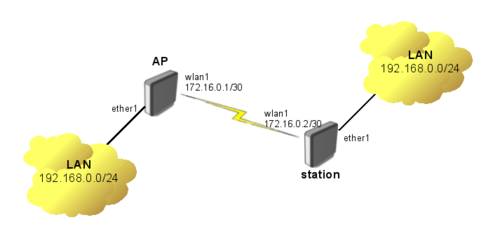Transparently Bridge two Networks using MPLS: Difference between revisions
Jump to navigation
Jump to search
No edit summary |
No edit summary |
||
| Line 17: | Line 17: | ||
Let us assume the following network setup: | Let us assume the following network setup: | ||
<br/> | |||
[[Image:wlink.png | 500px]] | [[Image:wlink.png | 500px]] | ||
Revision as of 10:59, 31 July 2009
Overview
This a very basic example how to enable MPLS, establish VPLS tunnel between two wireless links and use it to transparently bridge two networks.
Why we need this setup if we already have:
and both of those examples need less configuration effort?
There are two reasons:
- VPLS tunnel is about 60% faster than EoIP tunnel
- 802.11n limitation over wds bridge
Configuration
Let us assume the following network setup:

Note: For this setup mpls-test package must be installed.
AP
# --configure wireless access point-- /interface wireless set wlan1 disabled=no ssid=MPLS frequency=5180 band=5ghz mode=bridge # --configure IP-- /ip address add address=172.16.0.1/30 interface=wlan1 # --enable LDP-- /mpls ldp set enabled=yes lsr-id=172.16.0.1 transport-address=172.16.0.1 /mpls ldp interface add interface=wlan1 # --configure VPLS tunnel-- /interface vpls add name=vpls1 remote-peer=172.16.0.2 vpls-id=1:1 disabled=no # --add bridge and bridge ports -- /interface bridge add name=bridge1 /interface bridge port add bridge=bridge1 interface=ether1 add bridge=bridge1 interface=vpls1
station
# --configure wireless access point-- /interface wireless set wlan1 disabled=no ssid=MPLS band=5ghz mode=station # --configure IP-- /ip address add address=172.16.0.2/30 interface=wlan1 # --enable LDP-- /mpls ldp set enabled=yes lsr-id=172.16.0.2 transport-address=172.16.0.2 /mpls ldp interface add interface=wlan1 # --configure VPLS tunnel-- /interface vpls add name=vpls1 remote-peer=172.16.0.1 vpls-id=1:1 disabled=no # --add bridge and bridge ports -- /interface bridge add name=bridge1 /interface bridge port add bridge=bridge1 interface=ether1 add bridge=bridge1 interface=vpls1
Confirm that LDP is running
[admin@MikroTik] /mpls ldp neighbor> print
Flags: X - disabled, D - dynamic, O - operational, T - sending-targeted-hello, V - vpls
# TRANSPORT LOCAL-TRANSPORT PEER SEND-TARGETED ADDRESSES
0 DOTV 172.16.0.2 172.16.0.1 172.16.0.2:0 no 172.16.0.2
[admin@MikroTik] /mpls ldp neighbor> .. .. forwarding-table print
Flags: L - ldp, V - vpls, T - traffic-eng
# IN-LABEL OUT-LABELS DESTINATION INTERFACE NEXTHOP
0 expl-null
1 V 18 vpls1
Confirm that VPLS tunnel is established:
[admin@MikroTik] /interface vpls> monitor vpls1 once
remote-label: 17
local-label: 18
remote-status:
transport-nexthop: 172.16.0.2
imposed-labels: 17